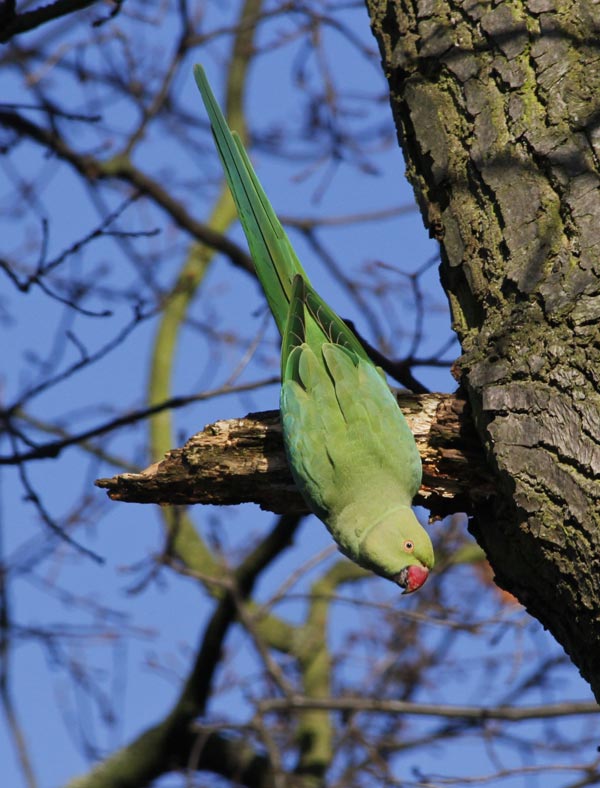
Rising Bioinvasion: Global Increase in Alien Species

The rose-ringed parakeet is native to parts of Africa and Asia. It was introduced as an ornamental species and has established populations at various sites in Europe, North America and Australia.
Photo: Tim M. Blackburn, University College London
The number of alien species is continuously increasing, and does not show any sign of saturation at a global level. This fact was described by an international team of 45 researchers, among them the Konstanz ecologist Professor Mark van Kleunen, in the renowned expert journal “Nature Communications”. They found that during the last centuries the number of new introductions has continuously increased worldwide, with more than a third of all first introductions recorded between 1970 and 2014.
“It had remained unclear whether or not the accumulation of alien species has already reached a point of slow-down”, says Dr Hanno Seebens from the Senckenberg Biodiversity and Climate Research Centre (BiK-F) in Frankfurt, Germany.
The first author of the study has an answer now: “For all groups of organisms on all continents, the number of alien species has increased continuously during the last 200 years. For most groups, even the rate of introduction is highest recently. Barring mammals and fishes, there are no signs of a slow-down and we have to expect more new invasions in the near future.”
Mark van Kleunen, professor of ecology at the University of Konstanz and one of the co-authors of the study, expects that the number of alien species will increase further in the near future – “as a consequence of climate change, which makes it possible for many alien plants in our gardens to jump the fence and settle in the wild”.
In the joint research project the researchers established a database of the date an alien species was first detected in a region outside the species’ native range. Using more than 45.000 of these first records of more than 16.000 alien species, they analysed the development of alien species accumulation during the last centuries.
The researchers found that 37% of all recorded alien species have been introduced in the last few decades between 1970-2014. At its peak, 585 new species were recorded within one year. This corresponds to more than 1.5 new alien species per day globally. “As the date of first record is not available for most alien species, these numbers are clearly underestimating the full extent of alien species introductions”, says Dr. Franz Essl from the University of Vienna, Austria, senior author of the study.
The trends of increase vary among taxonomic groups, which can be attributed to human activities. “We observe a distinct increase in first record rates of vascular plants in the 19th century, probably as a result of the intensification of horticulture. The rates of new introductions of other organisms such as algae, molluscs or insects increased steeply after 1950. This is most likely a consequence of the ongoing globalisation of trade,” explains Seebens, who earned his doctorate at the Limnological Institute of the University of Konstanz in 2008.
The unprecedented increase in alien species numbers can have extremely negative impacts on native ecosystems, as native plants might be eliminated and entire ecosystems change. Floras and faunas worldwide assimilate more and more, resulting in a loss of regional variety. Therefore various legislations are currently in force globally attempting to mitigate the introduction of new alien species. “However, our results show that the past efforts have not been effective enough to keep up with ongoing globalisation. There is an urgent need to implement more effective prevention policies at all scales”, concludes Essl.
Facts:
- 37% of all recorded alien species have been introduced in the last few decades between 1970-2014
- Creation of a database containing the date an alien species was first detected in a region outside its native range
- List of more than 45.000 first records of more than 16.000 alien species
- The Senckenberg Gesellschaft für Naturforschung (SGN), founded in 1817, is a non-profit organisation with headquarters in Frankfurt am Main and member of the Leibniz Association.
Original Publication:
Seebens et al.: No saturation in the accumulation of alien species worldwide. Nature Communications 8:14435 | DOI: 10.1038/ncomms14435
Note to editors:
You can download photos here:
https://cms.uni-konstanz.de/fileadmin/pi/fileserver/Bilder/13.2.2017/Grey_squirr…
Caption:
The eastern grey squirrel, originally from North America, was introduced to various locations worldwide, including the UK, where it has largely displaced the native red squirrel.
Photo: Tim M. Blackburn, University College London
https://cms.uni-konstanz.de/fileadmin/pi/fileserver/Bilder/13.2.2017/Rose-ringed…
Caption:
The rose-ringed parakeet is native to parts of Africa and Asia. It was introduced as an ornamental species and has established populations at various sites in Europe, North America and Australia.
Photo: Tim M. Blackburn, University College London
https://cms.uni-konstanz.de/fileadmin/pi/fileserver/Bilder/13.2.2017/Phytolacca_…
Caption:
A large population of American pokeweed (Phytolacca americana) in Hungary. This toxic plant is native to North America and was grown for ornamental and medicinal purpose in Europe.
Photo: Petr Pyšek, The Czech Academy of Sciences
https://cms.uni-konstanz.de/fileadmin/pi/fileserver/Bilder/13.2.2017/Lupinus_pol…
Caption:
The many-leaved lupine (Lupinus polyphyllus) is extensively used in mountain hay meadows in the The Katzbach Mountains in Poland. In Europe, this species has been planted as a fodder crop and as an ornamental, and is now widely naturalized.
Photo: Barbara Tokarska-Guzik, University of Silesia in Katowice, Poland, 2016.
Contact
University of Konstanz
Communications and Marketing
Phone: + 49 7531 88-3603
E-Mail: kum@uni-konstanz.de












